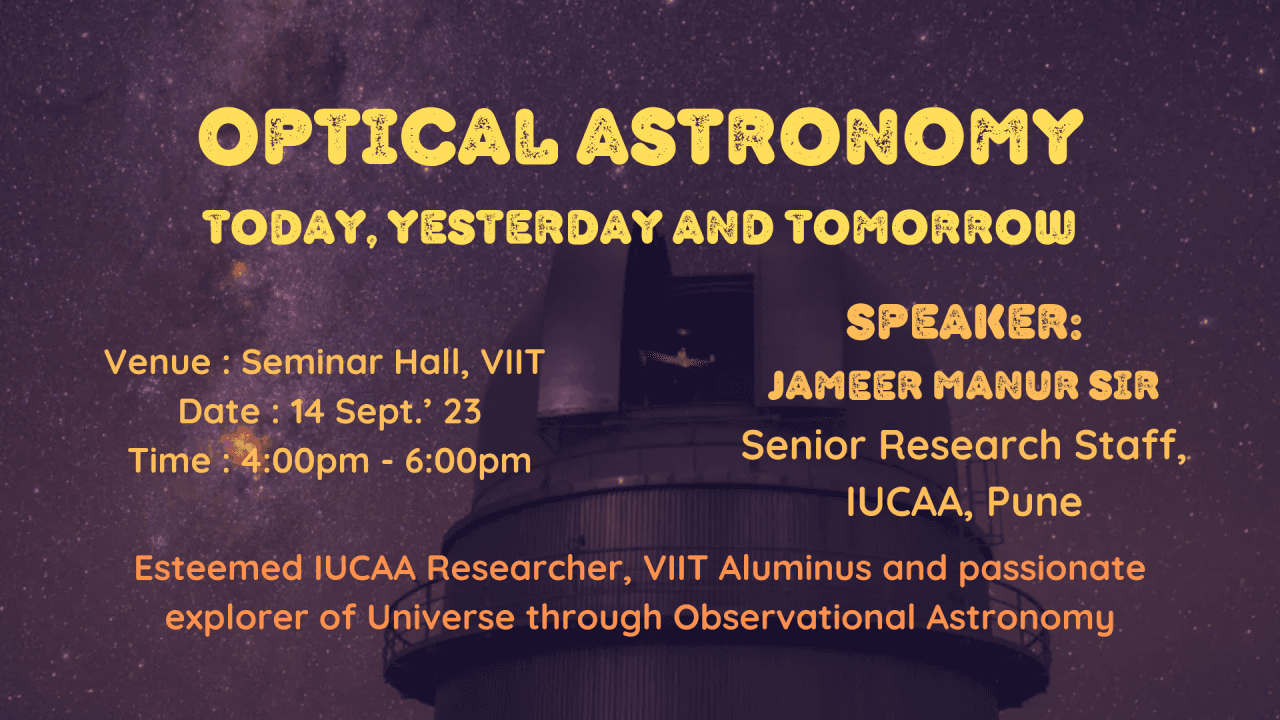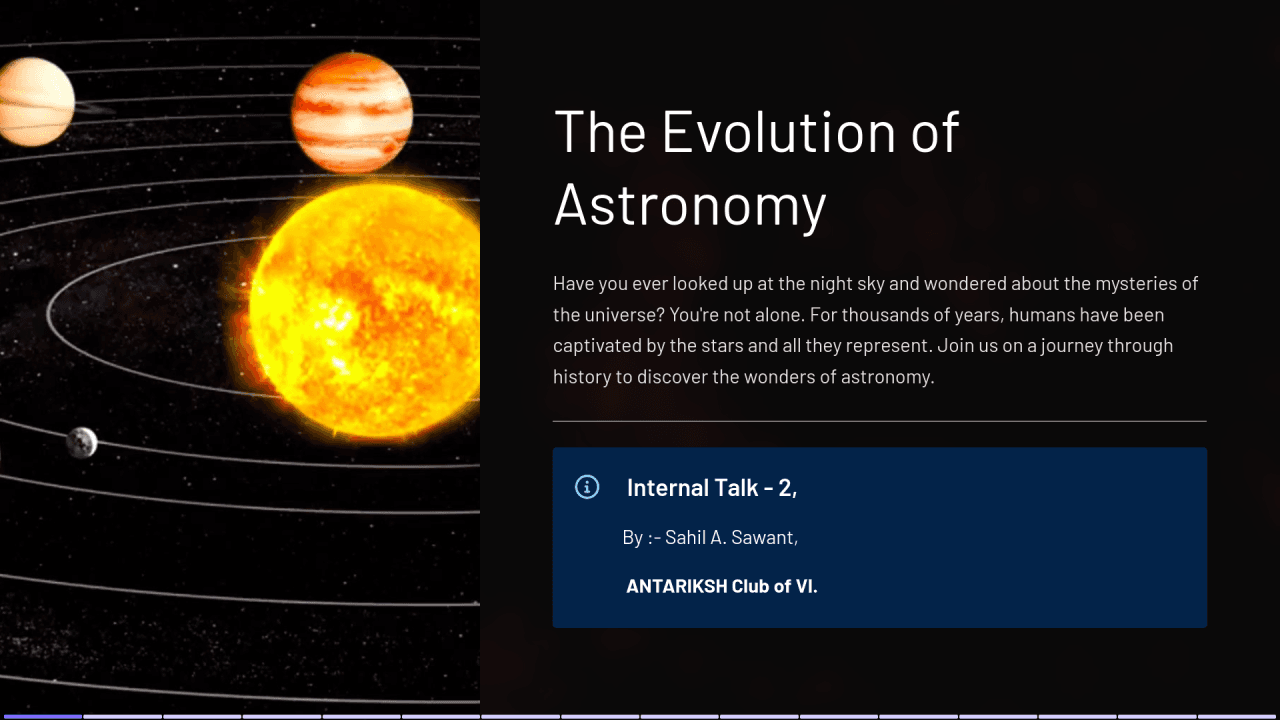Date: September 8, 2023
Venue: Lecture Room B304, Vishwakarma Institute of Information Technology (VIIT), Pune
Organizer: Antariksh Club, VIIT

On the enchanting evening of September 8, 2023, stargazers and cosmic enthusiasts gathered in Lecture Room B304 at the Vishwakarma Institute of Information Technology Vishwakarma Institute of Information Technology (VIIT) to embark on a captivating journey through the cosmos. The occasion was the much-anticipated internal talk hosted by the Antariksh - Astronomy Club , titled "Life Cycle of Stars." With a diverse audience ranging from seasoned club members to intrigued newcomers, the stage was set for a cosmic odyssey.
Talk Highlights:
Under the shimmering metaphorical canopy of the cosmos, Anas Ansari , a core member of the Antariksh Club, illuminated the audience with a celestial spectacle that spanned eons. Here are the dazzling highlights from his interstellar presentation:
Certainly, let's provide a more precise and scientific explanation of the key points, as if a professor is delivering the information:
1. Star Formation:
Stars begin their journey as clouds of gas and dust in space, primarily composed of hydrogen and helium. The process of star formation is initiated by gravitational forces. As these clouds condense and gather more material, they heat up due to the conversion of gravitational potential energy into thermal energy. Once the core temperature reaches around 10 million degrees Celsius, nuclear fusion reactions begin, converting hydrogen into helium. This marks the birth of a star, and this process occurs up to the point where elements like iron are formed.
2. Carina Nebulae:
The Carina Nebula is a region in space where new stars are born. It's a massive cloud of gas and dust where the conditions are right for gravitational collapse to occur. Inside this nebula, we find regions of higher density, often triggered by nearby supernova explosions or other cosmic events. These dense areas can lead to the formation of new stars as gravity pulls the material together.
3. Proto-Stage Star:
During the early stages of star formation, we have what we call proto-stars. These are young, developing stars that are still in the process of accumulating mass from their surrounding material. Gravitational forces are sculpting these proto-stars into the future luminous objects of our night sky.
4. Medium-Sized Star:
Within stellar nurseries, there's a delicate balance between the force of gravity pulling material inward and the pressure generated by nuclear fusion pushing outward. This equilibrium maintains the stability and form of a medium-sized star. It's during this phase that hydrogen is primarily being fused into helium in the star's core, releasing energy in the process.
5. Red Giant:
As a star ages and consumes its hydrogen fuel, it begins to expand and transform into a red giant. This phase occurs when most of the hydrogen in the star's core has been depleted. The core contracts and heats up, causing the outer layers to expand. During this process, heavier elements like helium are formed through fusion reactions in the core.
6. Super Red Giant:
Super red giants are massive stars in the late stages of their evolution. These celestial giants burn brightly and exhibit a pronounced increase in size compared to their earlier phases.
7. Planetary Nebulae:
In the final stages of a star's life, it sheds its outer layers in a process that forms a beautiful yet fleeting structure known as a planetary nebula. The outer layers become a diffuse cloud of gas and dust, while the star's core, now a white dwarf, gradually cools down over cosmic timescales.
8. White Dwarf and Hypothetical Black Dwarf:
White dwarfs are the remnants of medium-sized stars after they have exhausted their nuclear fuel. These are incredibly dense objects, primarily composed of carbon and oxygen. The concept of a black dwarf is theoretical and refers to a white dwarf that has cooled down completely, emitting no more radiation. However, this process takes longer than the current age of the universe.
9. Supernova Explosion:
Massive stars, much larger than our Sun, end their lives in a cataclysmic event called a supernova. The core of the star collapses under immense pressure, then rebounds, causing a powerful explosion. Supernovae are responsible for the creation of heavy elements and can outshine entire galaxies for a brief period.
10. Hypernova Explosion:
Hypernovae are even more energetic explosions that can occur in the most massive stars. These events result from extreme gravitational pressures, causing the star to break apart violently, releasing an enormous amount of energy.
11. Neutron Star and Black Hole:
When massive stars undergo supernova or hypernova explosions, their cores may collapse further, forming incredibly dense objects. Neutron stars are composed mainly of neutrons, and they can exhibit rapid rotation, emitting beams of radiation, known as pulsars. Black holes are regions of spacetime where gravity is so intense that nothing, not even light, can escape. They are formed when the core collapse is so extreme that it creates a gravitational singularity at its center.





Question and Answer Session:
The interstellar journey concluded with a thought-provoking Q&A session. Some of the stellar questions that ignited the room included:
1. What triggers the nebulae to start nuclear fission and become a star?
Anas Ansari eloquently conveyed the magic of gravitational collapse, the cosmic trigger that ignites the nuclear fusion in the heart of a star.
Gravitational collapse is the cosmic mechanism that initiates the process of star formation. As a cloud of gas and dust in space becomes denser, the force of gravity begins to dominate, causing the material to collapse in on itself. As the core of this collapsing cloud contracts and heats up, it reaches temperatures and pressures sufficient for nuclear fusion to commence. This marks the birth of a star. Nuclear fusion, not fission, is the process where hydrogen atoms combine to form helium, releasing an immense amount of energy.
2. What is the reason for the temperature difference in the layers of stars?
The room was alight with curiosity as Anas illuminated the intricate interplay of pressure, density, and fusion reactions, creating the mesmerizing temperature mosaic within stars. The temperature variations within a star are a consequence of the intricate interplay of physical processes. In the core of a star, where nuclear fusion takes place, temperatures can soar to millions of degrees Celsius due to the intense heat generated by these fusion reactions. Moving outward from the core, the temperature gradually decreases as energy radiates away from the core towards the surface. Factors such as pressure, density, and the specific fusion reactions occurring in each layer contribute to the temperature variations, creating distinct temperature layers within the star.
3. Can stars be reborn?
Anas Ansari masterfully navigated the cosmic cycle, explaining that while stars don't truly reincarnate, they undergo a magnificent metamorphosis, embracing new roles as white dwarfs, neutron stars, or enigmatic black holes. Stars, unlike living organisms, do not experience reincarnation. However, they do undergo a series of remarkable transformations throughout their life cycles. After exhausting their nuclear fuel, medium-sized stars, like our Sun, transform into red giants, shed their outer layers to form planetary nebulae, and eventually leave behind white dwarfs. These white dwarfs cool down over billions of years. In the far distant future, they may theoretically become black dwarfs. Massive stars, on the other hand, can end their lives in spectacular supernova or hypernova explosions, leading to the formation of neutron stars or black holes. These events mark the profound changes that stars undergo, although they are not truly reborn in the conventional sense.
Conclusion:
The Antariksh - Astronomy Club 's internal talk on the "Life Cycle of Stars" by Anas Ansari was a celestial odyssey that transported attendees across the cosmic tapestry, igniting their passion for the mysteries of the universe. The event not only showcased the club's dedication to fostering cosmic curiosity but also served as a testament to the limitless wonders that await exploration beyond our terrestrial realm.
As we bid adieu to this celestial evening, the Antariksh Club looks forward to continuing its mission of kindling the flames of wonder and discovery within the Antariksh community, promising more captivating cosmic journeys in the days to come.



